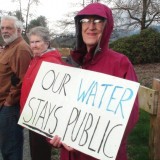The proposal to privatize the water services in my community seemed to hit us from behind – it was negotiated for over a year in secret and sprung on us without warning. This $300 million project, that would inevitably give control of our water to a foreign consortium, was not something Abbotsford or Mission residents asked for, but part of an agenda being pushed by the federal government and certain corporate individuals on Council.
To understand my experience and learn how to respond I turned to water documentaries such as FLOW (For Love Of Water) – a documentary about the privatization of drinking water – and saw that this is the typical modus operandi of P3 (public-private partnership) proponents. The film addresses the problems that have occurred in Europe with regard to water systems that are privately operated. However, most of the film is about P3s in the developing world in Africa and South America. I was surprised to find myself relating to the experiences of water consumers in those countries or villages. Even though I consider myself to be a strong, assertive woman, I wept at the similarity of what had happened to them and to what was now happening to my community of Abbotsford, B.C., Canada. I was amazed at the parallels between the fifth largest city in B.C. and communities in the developing world.
A number of concerned citizens of both Abbotsford and Mission have begun exhaustive research on the impacts of public-private water systems on consumers and communities. Water, is after all THE essential to all life. What became evident at the outset was that a very small percentage of water systems in Canada are the design, build, finance, operate model that the elected representatives of Abbotsford and Mission and their consultant Deloitte & Touche had opted to pursue. In B.C. and Canada the vast majority of local governments opt to have water systems operated publicly. Usually the private sector is limited to the design/build activities of water systems.
The need for more water was not a fact that Council members in both Abbotsford and Mission were unaware of. Two very extensive consultant reports were released in 2006 and 2009 that made it very clear that in order to approve more residential, commercial and industrial development much more water was needed. The estimated cost of the 2006 Water Master Plan was just under $197 million and in 2010 it was $198 million. Both Water Master Plans used costs related to Stave Lake as the source for additional water. A 2009 report prepared by Polis which recommended conservation as a way to have a sustainable water system and save up to 70% was released by the Abbotsford-Mission Water and Sewer Commission. See that report here.
Just months after the 2010 Water Master Plan was released the cost has gone up to $300 million, according to a Deloitte & Touche “business case” commissioned by the city. In addition, the cost to operate the public-private water system Stave Lake section would be $1+ million more per year over the proposed 25 year contract. Apparently, significant cost increases are quite common when P3 design/build and finance/operate “business cases” are submitted to senior governments for funding assistance. Historically, the assistance has been as much as 60% of the capital costs. The public-private “business case” for the Abbotsford/Mission water upgrade was submitted to PPP Canada Inc. – a relatively new crown corporation created by the Harper Conservative government in 2007. According to information available from the Government of Canada, PPP Canada Inc. will “grow” the P3 market in Canada; manage a $2 billion+ P3 Fund, providing up to 25% of municipal and provincial P3 costs; review and assess proposals for P3s seeking federal contributions using a new “P3 screen”; provide advice and expertise for P3 matters; and target municipal and small projects in particular.
Local governments have proclaimed that they have no choice but to opt for a public–private water system if they want to access federal funding (now lowered to 25%). With the P3 cat out of the bag a group of concerned water consumers from both Mission and Abbotsford met and formed Water Watch Mission-Abbotsford. News of this was met with a full page ad in the local media in Abbotsford and Mission, quoting Abbotsford Mayor George Peary erroneously accusing CUPE (the union that represents civic workers) of misleading the public about the impact of P3s. Then Deloitte & Touche was contracted and directed to not even consider anything other than the design/build and finance/operate option. Their recommendation was finally debated in public on Apr. 4, 2011. Abbotsford Council and staff refused to answer any questions. They looked like deer in the headlights according to one observer.
A large contingent of the public expressed such strong opposition to the P3 option that Council voted to delay the vote and (finally) address the numerous concerns voiced at the meeting. On the same evening with both Council and staff available to respond to concerns from the public, Mission Council decided to respect the concerns of its citizens and take the bull by the horns and voted the P3 water scheme down. This caused yet another very disrespectful public comment from Mayor Peary who humiliated residents by stating that the tail (Mission) would not be allowed to wag the dog (Abbotsford). Most of the water Abbotsford currently taps – from Norrish Creek – is not in Abbotsford but in Mission, as is Stave Lake.
Many hoped that would be the end of the P3 as both Abbotsford’s Water and Sewer Commission Report on the matter and the “business case” required both Councils to agree to the P3 water scheme. But as far as Mayor Peary was concerned it was still “full steam ahead”. When Abbotsford Council voted on April 18, 2011 on a quickly revised Deloitte & Touche “business case” – which “reduced” the cost to $284 million – to proceed with the P3 water scheme, one Councillor even expressed disgust at being bribed with our own money while we endanger our “gentleman’s agreement” with Mission, our longstanding working partner. However, during the recent federal election campaign Abbotsford Conservative incumbent candidate Ed Fast said that the P3 water scheme is not compulsory in order to obtain federal funds.
The voters of Abbotsford will now be asked to approve the P3 water project in a referendum in November 2011, including a long-term 25 year private contract to finance and operate the water system and the borrowing well over $50 million. The City of Abbotsford is launching a massive communications plan to convince the electorate to vote in favour of this privatization of their water services. However, public opposition to the idea is mounting, along with the logistical problem Abbotsford faces in accessing water located in Mission for which they need right-of-way access. In May Mission Council unanimously refused to consider a request by Abbotsford to grant access to Mission’s roads for the P3 project.
Abbotsford’s Mayor Peary is not making any friends by damning his neighbours in the media, chastising Mission Council and residents for their decision to keep their water system in public hands, and threatening to move forward with the project regardless of the will of Mission residents. There really is no room for bullying and egos when planning how to deliver water for life, not profit, to the public.
Lynn Perrin is the Abbotsford Spokesperson for Water Watch Mission-Abbotsford.
To learn more about the battle over Mission and Abbotsford’s water and how you can help:





